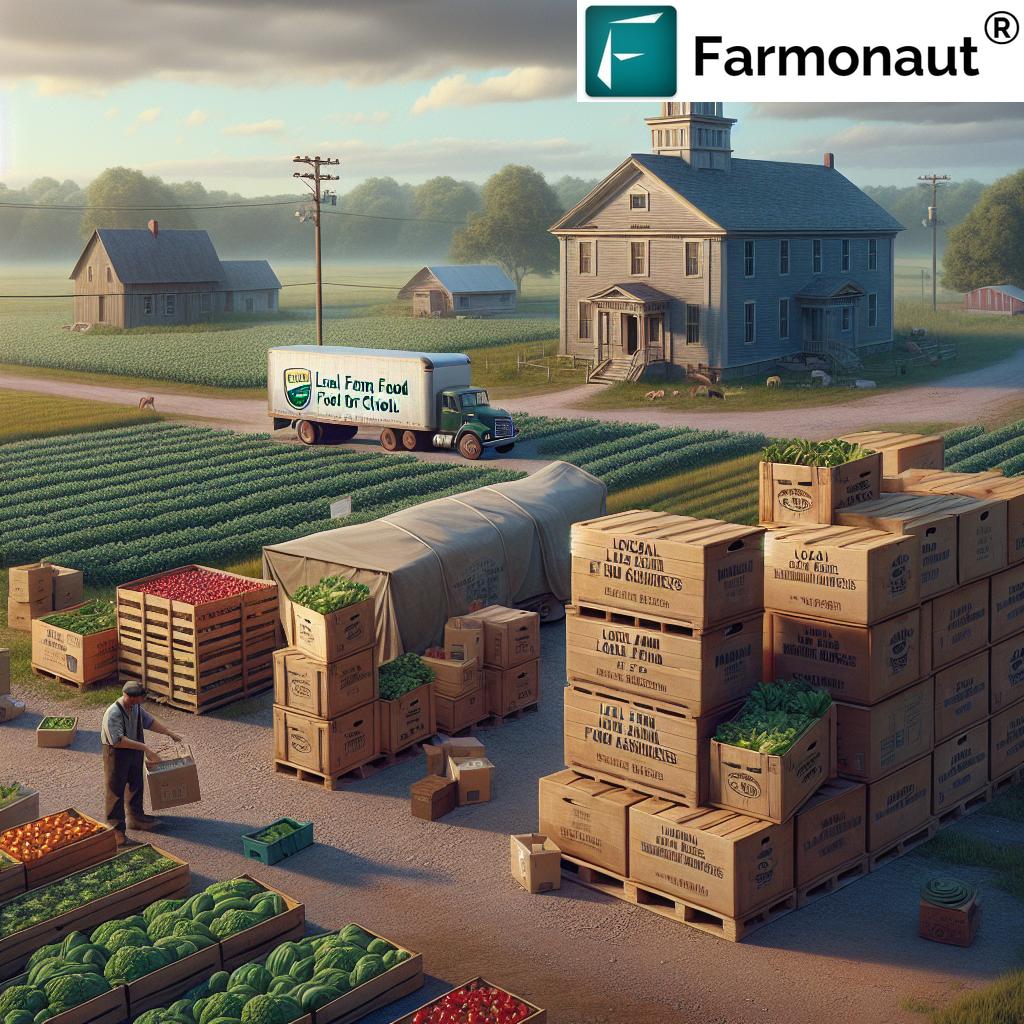5 Ways Glasgow Farm to School Funding Cuts Harm Local Farms
“Glasgow’s farm-to-school funding cuts risk reducing local farm sales to schools by up to 30%.”
Table of Contents
- Overview: What are Farm to School Programs?
- Federal Funding Cuts: The Glasgow, KY Reality
- Why Farm to School Matters for Local Farms
- 5 Key Ways Glasgow Farm to School Funding Cuts Harm Local Farms
- Data Table: Impact Comparison
- Farmonaut: Supporting Local Farming with Technology
- Strengthening Local Economies Through Schools: The Broader Picture
- Frequently Asked Questions
- Get Started With Farmonaut
- Conclusion
The sudden federal cuts to United States Agriculture Department (USDA) funding have cast a shadow over the vibrant connection between local family farms and schools in Glasgow, Barren County, Kentucky. As a school district devoted to nutritious, local produce, Glasgow’s loss of $3.2 million in state agriculture department grants in 2024 has upended years of progress.
Let’s delve into the consequences of these funding cuts—not just for Glasgow’s students, but for every local farm, family, and economy invested in farm to school programs. We will uncover the five major harms caused by lost school nutrition funding and show how modern agtech solutions from Farmonaut can help in an era of uncertainty.
“Over 60% of Glasgow’s family farms rely on school programs for stable income, now threatened by federal funding cuts.”
Overview: What are Farm to School Programs?
Farm to school programs bridge the gap between local agriculture and student nutrition. Through these efforts, schools can purchase local farm food—produce, meat, dairy—for lunchrooms, classroom learning, and even after-school snacks. Students discover where their food comes from, while family farms find stable markets and rural economies are revitalized.
In Barren County, Kentucky, and across Glasgow, such initiatives have long supported both our youth and our farmers. Until recently, generous state agriculture department grants—distributed through the USDA—made this possible. Local agriculture in schools went from novelty to necessity, with strong backing from dedicated educators and nutrition directors.
Federal Funding Cuts: The Glasgow, KY Reality
In early 2024, federal cuts to United States Agriculture Department funding led to a shutdown of crucial supports. The grants that allowed Barren County School District to prioritize local food purchases evaporated. CheyAnne Fant, director of nutrition programs, expressed hope for renewed funding while emphasizing the strain on the district’s ability to maintain robust programs.
- State agriculture departments relied on USDA grant distribution to boost local procurement in schools.
- Without these millions in annual grants, the economic benefits for both farms and families have started to unravel.
- Local farms and schools must now adapt or risk losing a critical partnership forged over decades.
Why Farm to School Matters for Local Farms
The importance of these programs is deeply felt in our Barren County communities. Farm to school programs support:
- Economic Security: Stable, predictable markets for family farms, insulating them from price volatility in larger commodity chains.
- Nutrition & Education: Fresher, more nutritious options for students and opportunities to teach about local agriculture.
- Sustainability: Shorter supply chains mean a smaller carbon footprint and fewer food miles traveled.
- Community Resilience: Investing locally keeps food dollars within our regional economies.
When funding is cut, the entire ecosystem—schools, students, farmers, and the environment—feels the strain.
5 Key Ways Glasgow Farm to School Funding Cuts Harm Local Farms
Let’s break down the five critical impacts that Glasgow and Barren County now face after losing school district funding for farm to school programs:
-
1. Lost Revenue and Economic Security for Family Farms
The most immediate effect of federal cuts is diminished income for local family farms. In fact, preliminary estimates suggest a 30% reduction in sales as schools scale back purchases of local farm food. This threatens the financial stability of over 60% of local farms who depend on school contracts for predictable, seasonal sales.
- Schools have historically represented a “guaranteed market” for thousands of pounds of fruits, vegetables, dairy, and meat.
- Funding cuts force schools to buy from larger or out-of-state suppliers, undermining our regional agricultural base.
- These trends destabilize farm operations, making it even harder for small and medium producers to make long-term investments.
Stable farm to school funding = sustainable family farms.
-
2. Reduced Student Access to Fresh, Local Food
The shutdown of school nutrition funding ripples quickly through student cafeterias. With less money to spend, districts gravitate to cheaper, bulk-supplied foods:
- Students experience fewer fresh fruits and vegetables as weekly menus fill with shelf-stable or frozen items.
- Local seasonal crops—like Barren County apples and greens—are replaced by national brands, severing that vital link to the community.
- The impact of federal cuts on schools in Glasgow also risks eliminating educational opportunities like garden-based learning and nutrition education.
This not only affects health but cultivates disconnect from food sources, reversing years of progress in local food literacy.
-
3. Weakening of Local Economies
One of the unsung benefits of farm to school programs is the circulation of food dollars within Glasgow and Barren County.
- Local purchases keep profits cycling among farm families, truck drivers, packaging suppliers, and rural businesses.
- Cuts to school funding mean fewer contracts for farmers, which reduces payroll, investment, and job creation throughout the local economy.
- With a substantial share of grants gone, strengthening local economies through schools becomes an uphill battle.
Ultimately, every dollar redirected to national or international conglomerates is a dollar lost from the Glasgow regional economy.
-
4. Setbacks for Environmental Gains and Sustainability Efforts
Local farm to school programs are not only about food—they are fundamental to environmental stewardship. Shorter transport routes mean less fuel use, fresher products, and reduced carbon emissions.
- Federal funding cuts increase food miles as districts shift to distant suppliers.
- This reversal undermines carbon footprint reduction initiatives and sustainability gains hard-won in recent years.
- Farm to school efforts often favor regenerative, eco-friendly producers—funding cuts risk crowding out these vital innovators.
Investing in sustainable purchasing is investing in our future—school district funding challenges can set us back substantially.
-
5. Erosion of Traceability and Food System Trust
When schools purchase outside the community, it becomes harder to track where food comes from and how it’s produced. Local farm programs, enhanced by advanced technologies like blockchain-based traceability, promote safety and transparency.
- Loss of local partners means food origin is less transparent and accountability decreases.
- Distrust grows among families who value knowing food comes from nearby, trusted sources.
- These gaps complicate nutrition tracking, allergy awareness, and efforts to build robust, safe school food systems.
Trust and transparency are cornerstones of a healthy food system—cuts threaten both.
Comparison Table: Potential Impacts on Local Farms from Funding Cuts
| Area of Impact | Estimated Before Cuts | Estimated After Cuts | Estimated Change (%) |
|---|---|---|---|
| Farmer Revenue | $1,500,000 annually from school sales | $1,050,000 annually | -30% |
| Number of Schools Participating | 100% public schools in Barren County | ~60% able to continue programs | -40% |
| Student Access to Local Produce | Fresh local produce 4 days/week | Fresh local produce 1-2 days/week | -50% |
| Community Economic Activity | $2,000,000 annual local economic impact | $1,300,000 annual impact | -35% |
| Environmental Benefits | Low food miles, reduced CO₂ emissions | Increased food miles, higher CO₂ emissions | Significantly Reduced |
Farmonaut: Supporting Local Farming with Technology
As Barren County’s school district grapples with funding challenges, embracing digital innovation pays practical dividends. Farmonaut provides advanced agricultural technology—available through Android, iOS, web apps, and API—delivering precise, actionable insights for all types of farmers.
- Satellite-Based Crop Health Monitoring helps farmers in and around Glasgow maximize yields, reduce input waste, and adapt quickly as program supports fluctuate.
- Jeevn AI Advisory System gives farm leaders access to real-time weather, crop diagnostics, and efficiency tips—boosting resilience in uncertain times.
-
Blockchain-based Product Traceability offers transparent supply chain documentation, reassuring schools and parents that food quality and safety are preserved, even without financial support.
- Enhance trust in local agriculture with Farmonaut’s traceability platform.
-
Carbon Footprinting Tools enable farms and districts to measure and reduce their environmental impact, a critical sustainability goal for the future.
- Learn more about Farmonaut’s carbon footprint solutions.
-
Fleet and Resource Management keeps farm operations lean—even when transport and logistics must stretch farther due to food miles.
- Explore fleet management for agribusinesses.
-
API Integration allows agricultural research groups and developers to embed satellite and weather intelligence directly into their own systems.
- Check the Farmonaut API and Developer Documentation for integration details.
All these tools are designed to be affordable and scalable, echoing Farmonaut’s commitment to UNLOCKING precision farming for every farm—large or small—in Barren County and beyond.
Supporting Larger-Scale Farm Management in Times of Change
For cooperatives and government programs seeking to maximize food production and efficiency despite loss of support, Farmonaut’s large scale farm management platform simplifies monitoring diverse lands, managing teams, and tracking real-world outcomes over hundreds or thousands of acres.
Strengthening Local Economies Through Schools: The Broader Picture
The Glasgow experience is a microcosm of a much larger trend. Across the United States, more than 42,000 schools once participated in farm to school programs—injecting millions into rural economies, supporting tens of thousands of family farms, and championing healthier student diets.
- State agriculture department grants have always been a linchpin; as federal cuts trickle down, the race to maintain these gains intensifies.
-
When healthy, robust school food procurement works, every stakeholder wins:
- Schools offer the best food for kids at lower environmental cost.
- Family farms can invest in staff, equipment, and future generations.
- Local economies become more resilient to shocks.
- Parents and communities enjoy greater transparency and food safety.
- Farmonaut supports this arc toward sustainability by providing data-driven insights—even when dollars dry up, the intelligence needed for efficiency and resilience remains in farmers’ hands.
Barren County’s steadfast commitment ensures that farm to school programs will never end. But strong advocacy, smarter resource use, and innovative technology are all essential to safeguarding these programs for the long haul.
Choose Your Farmonaut Subscription
Farmonaut offers flexible, subscription-based models to suit single farms, co-ops, government bodies, and researchers. Select from various monitoring plans, customizable options, and seamless integrations with mobile and web platforms.
Ready to empower your farm, school, or business? Find the right plan below:
Frequently Asked Questions
What prompted the recent funding cuts affecting Glasgow’s farm to school programs?
The federal cuts to the United States Agriculture Department’s budget have led to a shutdown of key programs that funded local farm food purchases in schools. States like Kentucky lost essential grants distributed by the USDA, directly impacting Barren County’s abilities to keep local agriculture in schools.
Which areas of local farming are most impacted by the school district funding shutdown?
The primary impacts have been to farmer revenue, student access to fresh food, community economic activity, the percentage of schools able to participate, and environmental benefits accrued from local sourcing.
Can farm to school programs continue in Glasgow despite lost funds?
According to the Barren County School District, farm to school programs will never end, but the loss of funding makes it significantly harder to maintain robust local purchasing. Efforts will need to rely more on local partnerships, innovation, and careful resource planning.
How can technology like Farmonaut help local farms in funding crises?
Farmonaut’s satellite-based crop monitoring, AI advice, carbon footprint tracking, and traceability solutions help local farms optimize yields, document their practices, and compete for new markets by demonstrating sustainability—even when school funding is tight.
What steps can Glasgow’s schools and farms take to recover or adapt?
Strategies include adopting precision agtech for improved efficiency, seeking new private or local government support, and leveraging consumer demand for traceable, sustainable, local food. Staying organized and data-driven can help offset immediate challenges from federal school nutrition funding losses.
Conclusion: Resilient Farming & School Nutrition for Glasgow
Glasgow and Barren County’s farm to school story is a testament to the extraordinary power of community, local food systems, and the symbiosis between schools and family farms. While federal funding cuts have tested these bonds and challenged the future of farm to school programs, innovation and advocacy are more important than ever.
With advanced technologies like Farmonaut’s satellite solutions and AI-driven insights, local agriculture can not only weather these storms, but thrive—continuing to nourish our children, support our economies, and protect our environment.
-
Stay connected: Download the Farmonaut app for actionable farming insights.
Click here for the Web App - Leverage API integrations for research or large-scale management.
- Remain actively engaged with school boards, state departments, and family farms—every voice strengthens the case for resourceful, resilient rural education.
Together, we can ensure the future of farm to school programs in Glasgow, KY, and beyond—empowering our students, supporting our family farms, and fortifying our local economies.






















